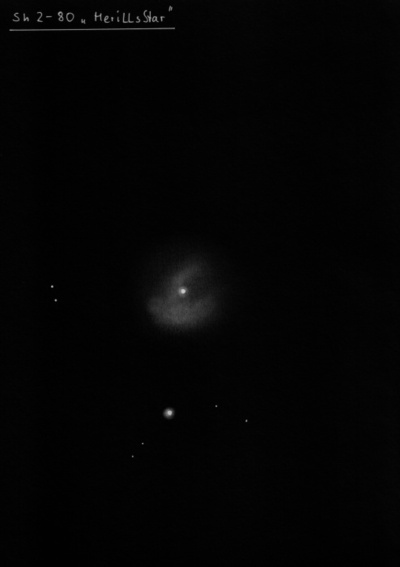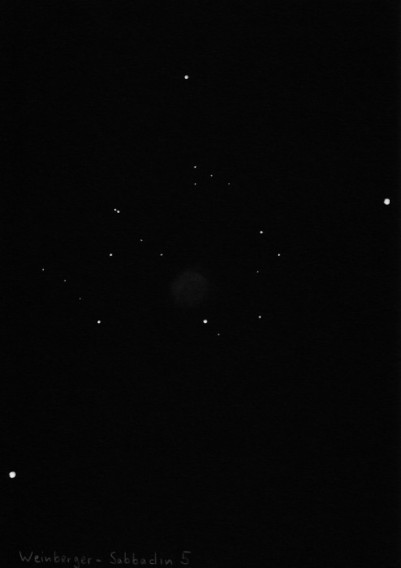The third smallest constellation in the northern sky, located in the rich Milky Way in the Summer Orientation Triangle. Although the constellation consists of only 3rd and 4th magnitude stars, it can be found immediately. It is rendered by the stars α, γ, δ, and ε Sagittae, which indeed resemble the shape of an ancient arrow, located 10 degrees SSE of Altair of Orleans. The arrow lies along the eastern branch of the summer Milky Way - between Eagle and Fox. Its star field is especially nice in binoculars, binars and eyepieces of telescopes with a large field of view: a wealth of 6-9mag stars are scattered in a faint faint "glow". The constellation contains one of Messier's objects, the globular cluster M71, and a few interesting variable stars. "A little bit of each roll" is also found here, along with a few clusters, emission or planetary nebulae, and binaries.
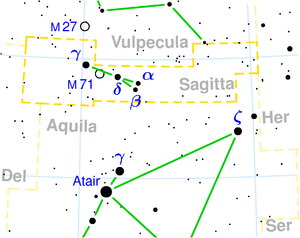
γ Sge - The brightest star of the constellation has an apparent magnitude of 3.71. It is an orange giant of spectral class K5, shining from a distance of approximately 258 light-years.
Sham (α Sge) - The name, introduced about 200 years ago by Giuseppe Piazzi, an Italian astronomer who discovered the first asteroid Ceres, is based on the ancient Arabic name Sahm - arrow. This yellow giant of spectral class G0 has a brightness of 4.4mag and is located 382ly away. It has four faint companions.
ζ Sge - The main star with a brightness of 5.5 mag has a companion with a separation of 8.6". In smaller telescopes, they appear as a closely separated pair of unequal brightness. The main star is a physical binary, indistinguishable with amateur telescopes - it appears as a bright yellow, while the companion is blue. The system is located at a distance of 260 light-years. At a separation of 76", there is a fourth star with a magnitude of 11 mag in the sky.
θ Sge - The asterism is observed along the southwest boundary of the inconspicuous open star cluster NGC 6873, which is located in the same field of view in a larger telescope. In a 100 mm telescope, the components AB appear pale yellow (6.5 mag), and at a separation of 84", there is also a third, orange star of magnitude 9.
U Sge - In a period of 3.38 days, the brightness of this eclipsing variable star of Algol type changes from 6.6 mag to 9.2 mag. It is suitable for observation even with a small telescope, as the changes near the beginning and end of the minimum can be observed within a few minutes. The eclipse, which occurs approximately once every three and a half days, lasts for approximately one hour and forty minutes. The primary component is a blue main sequence star, while the larger but fainter companion is a yellow giant.
Herschel 84 - A binary star consisting of a primary orange component (6.5 mag) and a secondary blue component (8.9 mag) with a separation of 28.2". In at least a 100 mm telescope and higher magnification, it is one of the most beautiful binary stars in the constellation.
V Sge - Probably once a "new star", today almost at the limit of visibility in a telescope. It is almost always different in brightness every night, its magnitude unpredictably ranging from 8.6 to 13.9.
M 71
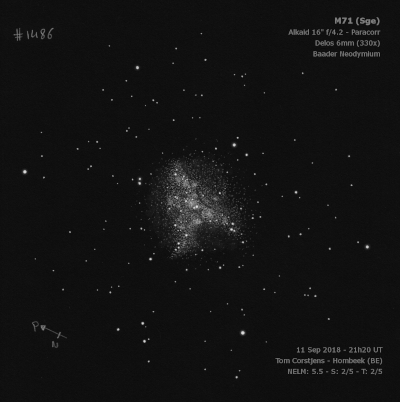
15x50mm IS binoculars (6/19/09): bright, obvious glow is elongated with a brighter center.
Philippe de Chéseaux discovered M71 = NGC 6838 = h2056 in 1745-46. Johann Koehler independently rediscovered it between 1772 and 1779 with a 6-foot Dollond telescope at only 30x and noted "a very pale nebulous patch in the Arrow [Sagitta]." Pierre Méchain found it again on 28 Jun 1780 and he is credited with the discovery in the NGC.
WH first observed the cluster on 30 May 1783 using his 8-inch (10-ft focal length) and noted it was "resolved into stars. I can count between 20 and 30 of them." He viewed it several times in his larger scopes and logged "a very compressed cl of stars." on 18 Aug 1784 (sweep 252) and "a cl. of stars; the stars pretty large, nf is a part seemingly separated" on 18 Sep 1784 (sweep 276). JH recorded on sweep 90, "vL; loose; fills field; a fine object; stars 11...16m; the most condensed part = 3', of an acute triangular figure, the angle northwards."
200/250mm - 8" (10/4/80): many faint stars were resolved with averted. The west edge is brighter.
300/350mm - 13.1" (7/16/82 and 8/22/87): a few dozen stars are resolved over haze, only weakly concentrated, non-symmetrical shape. Impression that many faint field stars may be superimposed. Located in a very rich star field.
400/500mm - 17.5" (8/5/94): roughly 75 stars resolved in a 5' diameter but has a very irregular ill-defined outline to the halo. The brightest section is elongated SSW-NNE with dimensions 3'x2'. The brightest star is on the east side of the core and is a close double. Located in a rich field with likely many field stars superimposed around the halo. Located just south of the midpoint between Gamma and Delta Sagittae.
Harvard 20, less than 30' SSW, contains about three dozen stars in a 6'x3' field, elongated ~E-W. Two bright mag 9 stars are off the west side but the cluster is dominated by 20 mag 12/13 stars. Also includes a scattering of faint mag 14-15 stars. A pretty evenly matched mag 12.5/12.5 double star is at the east end and an uneven mag 12/14 double star is to the west of the well matched double.
600/800mm - 24" (9/2/16): at 200x and 375x; beautifully rich cluster mostly defined by an intense triangular central or core region with vertices on the north, southwest and southeast corners and sides ~3', 3' and 2.3'. Roughly 100 stars are densely packed over the background glow within this triangular outline, though the north end is less well defined. The surface brightness falls off rapidly outside this core, though the halo includes some brighter stars, and the cluster blends into the fairly rich field density beyond a diameter of 5'. Open cluster Harvard 20 lies 28' SSW.
Notes by Steve Gottlieb
NGC 6886
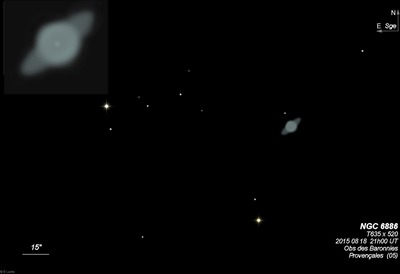
Ralph Copeland discovered NGC 6886 on 17 Sep 1884 at Dun Echt, Scotland, using a direct vision objective-prism or Secchi prism attached to a 6.1-inch refractor. He recorded "Nebula about 2 1.2" diam, equal to a 9.8 mag star." His micrometric position in Monthly Notices XLV is very accurate.
Based on Crossley photographs taken at Lick, Heber Curtis (1918) noted, "no central star can be made out. A round disk 6" in diameter, of nearly equal brightness throughout, forms the central part. Two wings (of ring structure) in p.a. 135-315° bring the total length to 9"."
300/350mm - 13.1" (9/29/84): fairly bright, very small, just non-stellar at 166x. At 415x, easily visible small disc elongated ~E-W. Forms the NW vertex of a thin isosceles triangle with a mag 10.5 star 45" SSE and a mag 10 star 1.5' E. These two brighter stars form a parallelogram with two mag 12 stars to the SE with sides of 1' and 1.5'.
400/500mm - 17.5" (11/6/99): this compact planetary was easily identified by blinking at 100x using an OIII filter as a "soft" mag 11 star. A small disc, less than 10" diameter is visible at 220x without filter. Situated at the NW vertex of a small isosceles triangle with a mag 11 star 0.8' SSE and a mag 10 star 1.6' E. The nearer star is double with a faint companion close north. NGC 6886 is clearly non-stellar at 280x-380x and slightly oval.
Notes by Steve Gottlieb
IC 4997
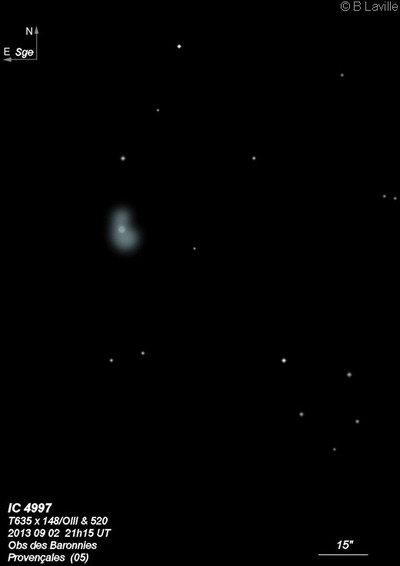
Williamina Fleming discovered IC 4997 = Fleming 97 in 1896 during an examination of stars with unusual spectra on a Harvard objective prism plate. The discovery was reported by Pickering in the Harvard College Observatory, Circular No.9 in July 1896. According to Wolfgang Steinicke, Gustav Gruss independently visually discovered IC 4997 around 1896, using a 6" or 8" refractor with the aid of a spectroscope, so both deserve discovery credit.
Based on Crossley photographs taken at Lick, Heber Curtis (1918) reported IC 4997 was "indistinguishable from a star on the Crossley negatives, but shown to have a minute disk visually with the 36-inch."
300/350mm - 13" (7/85): bright stellar planetary at all powers, confirmed with an OIII blinking from El Cerrito. A slightly brighter mag 10.4 star for comparison blinking is 1.1' SW.
400/500mm - 17.5" (8/18/01): the PN appears as an unusually bright mag 11 "star" (V = 10.8) at 100x in a rich star field. Verified with OIII blinking. An excellent comparison star is a mag 10 star just 1' SW. A 12th mag star 2' WSW completes a distinctive obtuse triangle. With the filter the PN is nearly one magnitude brighter than the 10th mag star. At 280x, the PN is bluish and a tiny disc was highly suspected, perhaps 2"-3".
Notes by Steve Gottlieb
NGC 6879
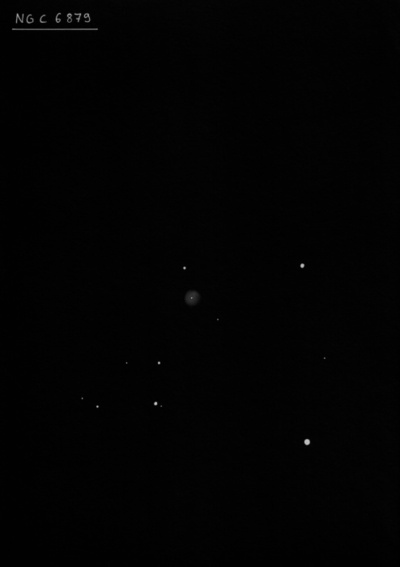
Edward Pickering discovered NGC 6879 = HN 55 on 8 May 1883 using a direct-vision spectroscope with the 15-inch refractor at Harvard College Observatory. The discovery was communicated directly to Dreyer (probably in 1885) and not published until 1908 (Harvard Annals 60). Ralph Copeland independently rediscovered it on 9 Sep 1884 at Dun Echt, Aberdeen using an objective-prism with a 6.1-inch Simms refractor. He remarked "equal in brightness to a star 10.2 mag. Diameter 4.6" by micrometric. It has an 11 mag star at 222.27°, distance 83.2"." His micrometric position in Monthly Notices XLV 2 is very accurate. Both Pickering and Copeland are listed as discoverers in the NGC. Sherburne Burnham described it in 1911 at Yerkes as resembling an out of focus star of of mag 10.7 and he measured a diameter of 3.7".
Based on Crossley photographs at Lick, Curtis (1918) wrote "A minute disk, 5" in diameter, just distinguishable from a star. Fades out slightly at the edges."
300/350mm - 13" (7/85): observation from El Cerrito: stellar planetary at all powers, confirmed by OIII blinking, estimate V = 12.0. A similar mag 12 star is 1.4' SW. Located 14' NE of ∑2634 = 7.9/9.4 at 5".
400/500mm - 17.5" (9/5/99): picked up at 100x with OIII blinking as a mag 12 "star" by star hopping from the double star ∑2634 = 7.9/9.4 at 5" which is 14' SW. A good comparison star for blinking is situated just 1.5' SW. At 280x, the PN has a slight bluish tinge with a "soft" edge. At 380x, a very disc ~4" is resolved with a brighter center. The disc is easier at 500x and a mag 16 star is occasionally visible at the north edge.
600/800mm - 24" (9/2/16): picked up at 200x unfiltered as a slightly soft, pale blue "star". Excellent response to an OIII filter. A slightly brighter 12th mag star is 1.4' SW, though with the filter the planetary dominates this star. Improved view at 286x and 375x. A small 5" disc is easily resolved. Nearby a mag 13.5 star is 50" WNW and a mag 14 star 50" SSE. At 500x, a 15-15.5 mag star is just off the north side (15" separation) and another 15th mag star is 30" SSE. The center is brighter but the seeing wasn't steady enough to resolve the central star.
Notes by Steve Gottlieb
Pal 10
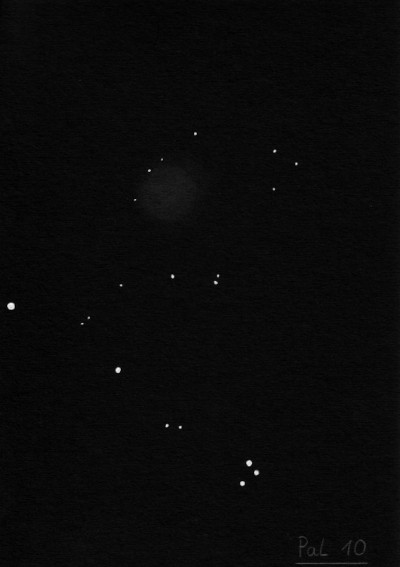
| Type | GC [XII] |
| RA | 19:18:00.0 |
| Dec | +18:34:00.0 |
| major_axis | 4.0' |
| mag | 13.2 |
| surface_bright | 16.0 |
K 4-10
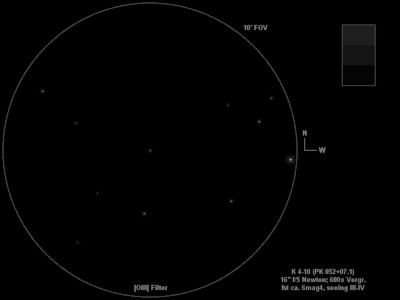
| Type | PN |
| RA | 18:59:03.8 |
| Dec | +20:37:01.0 |
| major_axis | 30.0'' |
| mag | 13.6 |
| surface_bright | 11.8 |
K 3-51
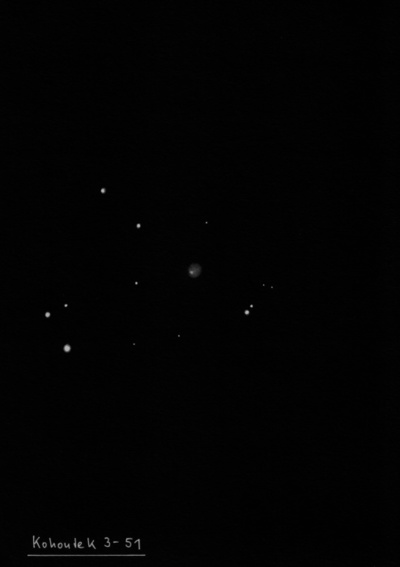
| Type | PN |
| RA | 20:02:36.4 |
| Dec | +17:36:50.0 |
| major_axis | 18.0'' |
| mag | 14.8 |
| surface_bright | 11.5 |
Hen 1-5
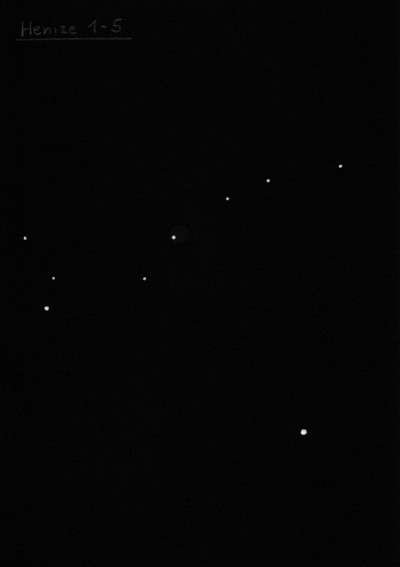
| Type | pA* |
| RA | 20:11:56.1 |
| Dec | +20:20:04.0 |
| major_axis | 42.0'' |
| mag | 16.0 |
| surface_bright | 14.9 |
K 1-17
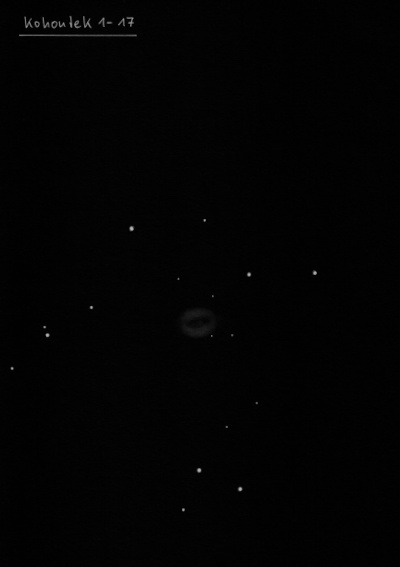
| Type | PN |
| RA | 19:03:37.4 |
| Dec | +19:21:22.0 |
| major_axis | 48.0'' |
| mag | 16.0 |
| surface_bright | 15.1 |
Abell 63
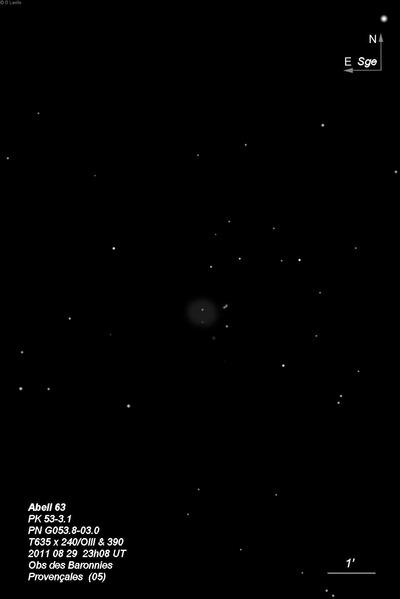
| Type | PN |
| RA | 19:42:10.3 |
| Dec | +17:05:14.0 |
| major_axis | 36.0'' |
| mag | 17.1 |
| surface_bright | 15.6 |
Abell 59
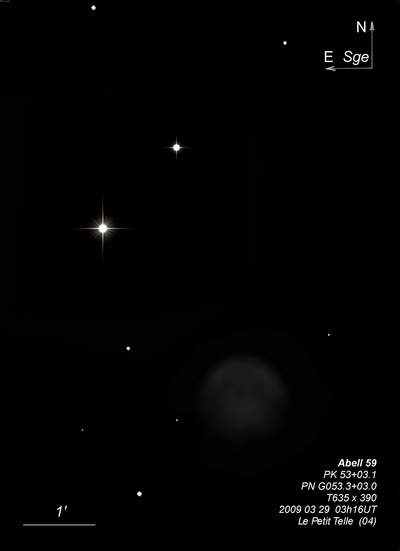
| Type | PN [3b] |
| RA | 19:18:40.0 |
| Dec | +19:34:33.0 |
| major_axis | 96.0'' |
| minor_axis | 78.0'' |
| mag | 17.2 |
| surface_bright | 17.7 |
